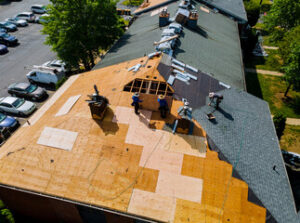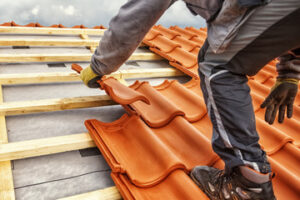Metal roofing can add to your home’s energy efficiency by reflecting radiant heat and keeping your home cooler in summer. However, it’s important to choose a reputable roofing contractor with experience in working with this material.

Professional roofers specializing in metal roofing offer valuable consultation to help homeowners select the right color, material, and panel profile for their property. They also offer different types of warranties, including weathertight and paint warranties. Contact Metal Roofing Company Missoula for professional help.
The durability of metal roofing is one of the main reasons homeowners choose it over shingle roofs. This roof type can withstand winds of up to 140 miles per hour and will not crack or corrode, unlike traditional shingles. It also has a Class A fire rating, which makes it safe during lightning strikes. In addition, metal roofs can be fitted with solar panels. In fact, the combination of a high-quality roofing system and efficient solar panels can help homeowners reduce their energy bills.
A metal roof can last between 40 and 70 years, depending on the material used. In comparison, a traditional asphalt shingle roof can last up to 12 to 20 years. In addition, a metal roof can withstand harsh weather conditions and extreme hail storms. Some types of metal roofing even come with 30- to 50-year manufacturer warranties.
When it comes to choosing a metal roofing company, it’s important to select one that has experience installing this type of roof. This will ensure that all aspects of the installation adhere to industry standards, promoting longevity and adding to property value. Involving a professional roofing contractor will also ensure that any potential issues with the roof’s construction or finish are addressed before they become major problems.
A metal roof can be made from a variety of materials, including copper and steel. Typically, it starts out as coil and is then slit and processed. This process produces a sheet or panel, which is then rollformed into the desired profile and ribbing structure for a metal roof. These panels are then connected together and sealed to form the complete roofing system. Accessories, such as fasteners, clips, underlayment, and sealant are also needed to complete the system.
Energy efficiency
Many homeowners are now seeking energy-saving building materials for their home renovations. These products cut costs on energy bills and reduce the amount of waste that is generated by buildings. They also help to reduce carbon emissions, which is good for the environment. Metal roofing is one of the most energy efficient roofs available. It reflects solar rays instead of absorbing them, which can lower cooling costs and reduce the amount of electricity used by a building. It can also be enhanced with specialized coatings to make it even more energy efficient.
Another way to increase the energy efficiency of a metal roof is by installing a reflective underlayment. This layer is placed between the roof deck and the metal roof to prevent leaks and to improve insulation. This type of underlayment can save homeowners up to 40 percent in cooling costs. It is also made of recycled material, which is good for the environment.
When choosing a metal roof, it is important to choose a high-quality product from a trusted manufacturer. This will ensure that the roof lasts for years and is protected from weather elements. A quality roof can increase the resale value of a property. It will also reduce the amount of money that a homeowner will need to spend on repairs and maintenance in the future.
Another important factor in determining the best metal roof is the climate in which it will be installed. Some climates are more humid than others, which can affect the longevity of a roof. In addition, a metal roof can rust more easily in wet and coastal climates. In these cases, it is important to maintain a regular inspection schedule to keep the roof in its best condition.
Low maintenance
While metal roofs are very durable, they do require some maintenance to protect the health and lifespan of the roofing system. Regular inspections are critical to spot problems that may occur over time, and addressing these issues as they arise can save you the expense of a costly repair down the road.
A common mistake homeowners make is waiting until they see obvious signs of damage or a leak to take action on their roof. This can lead to extensive damage, and even complete roof replacement, which is often more expensive than simply catching up on regular maintenance. A professional roofing contractor can perform the majority of the maintenance tasks needed to keep a metal roof in great shape for decades.
Metal roof maintenance typically consists of a general lookover to ensure there are no obvious issues and to check on the condition of existing sealant. These sealants prevent water, dirt, and other elements from penetrating the roof, causing rust or corrosion, and creating leaks. Sealants can last for many years, but they do need to be reapplied regularly.
Other routine tasks include checking the condition of flashing, which comprises strips of metal installed around the edges and joints of the roof as well as areas surrounding penetrations such as chimneys, pipes, vents, and skylights. During these inspections, the contractor will ensure that the flashing is not loose, cracked, or rusty. It will also re-caulk any gaps to prevent water from entering the home, and this is one of the most common causes of roof leaks.
The contractor will also look for debris such as leaves, branches, or twigs that could become stuck on the roof and stain or scratch the paint system. In addition, he or she will inspect gutters and drains to ensure that the water is flowing freely off of the roof and doesn’t pool or cause other problems.
Aesthetics
Metal roofing offers a captivating blend of aesthetics and practicality, providing a sophisticated and modern exterior for homes. With a wide range of style and color options, homeowners can customize their roofs to complement the unique aesthetic of their home or business. With an unparalleled combination of durability and versatility, metal roofs have become a popular choice among architects and homeowners alike.
Metal roofs come in a variety of shapes and designs to suit various architectural styles, incorporating features such as raised seams and sleek, uninterrupted surfaces. Standing seam metal roofs offer a more traditional aesthetic, while corrugated and shingle-style metal roofs can provide a more contemporary look. Moreover, metal roofs are available in a wide range of colors and finishes, which allows designers to match them with a variety of other architectural elements. For example, copper roofs develop a distinctive green patina over time, while galvanized steel can take on a weathered finish for an old-world feel.
The color of a metal roof is an important factor in its aesthetic, as it determines how the structure will appear from the street. The right color can create a visual contrast with other architectural elements and highlight the design of a building. Additionally, the right color can also help a metal roof to comply with local energy efficiency codes.
Aesthetics aren’t just about the way a roof looks; it also determines how long it will last. It’s essential to select a roofing contractor that has extensive experience in installing metal roofs. Choosing a reputable contractor will ensure that your roof is properly installed and can withstand the elements for decades to come.
When selecting a roofing contractor, make sure to ask for references and reviews from previous clients. A reputable contractor will have a good track record of customer satisfaction and a high level of professionalism.
Recyclability
The recyclability of metal roofing makes it a great choice for homeowners who want to reduce their carbon footprint. The material can be recycled for a new roof at the end of its lifespan, which cuts down on landfill waste and reduces the need for oil-based products. Plus, it’s available in a wide range of styles and colors, so you can match your metal roof to the surrounding environment.
The manufacturing process for metal roofing uses less energy than shingle production, and it produces far less scrap. Additionally, metal roofs are fabricated to custom measurements, which eliminates waste from cutting and shavings.
Most metal roofing materials contain a high percentage of recycled content and can be fully recyclable after their long service life. In contrast, conventional shingles are made of petroleum-based products and can only be reused a limited number of times before they’re rendered useless.
When shopping for a metal roofing contractor, be sure to find one who has good relationships with local recycling centers. These contacts will help you make sure your roof is properly recycled after its service life. They can also provide you with valuable information about the local laws governing recycling and sustainability practices.
You can also ask an architect or builder for a recommendation. They are often well connected in the industry and will be able to direct you to contractors with proven track records of quality work. If possible, try to visit a few potential contractors’ sites to see their work in person. This will give you a sense of their capabilities and determine whether they are the right fit for your project. You can also look for online reviews to see what other customers have had to say about their services.

